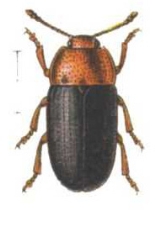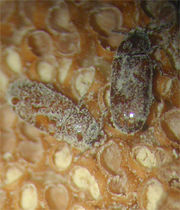
Erotylidae
Encyclopedia
Erotylidae is the pleasing fungus beetles, is a family
of beetle
s containing over 100 genera
. In the present circumscription, it includes the subfamilies Dacninae, Encaustinae, Erotylinae, Megalodacninae, and Tritominae. In other words, the narrowly-circumscribed Erotylidae correspond to the subfamily Erotylinae in the definition sensu lato. They feed on plant
and fungal matter; some are important pollinator
s (e.g. of the ancient cycad
s), while a few have gained notoriety as pests of some significance. Sometimes, useful and harmful species are found in one genus
, e.g. Pharaxonotha. Most pleasing fungus beetles are inoffensive animals of little significance to humans however.

Family (biology)
In biological classification, family is* a taxonomic rank. Other well-known ranks are life, domain, kingdom, phylum, class, order, genus, and species, with family fitting between order and genus. As for the other well-known ranks, there is the option of an immediately lower rank, indicated by the...
of beetle
Beetle
Coleoptera is an order of insects commonly called beetles. The word "coleoptera" is from the Greek , koleos, "sheath"; and , pteron, "wing", thus "sheathed wing". Coleoptera contains more species than any other order, constituting almost 25% of all known life-forms...
s containing over 100 genera
Genus
In biology, a genus is a low-level taxonomic rank used in the biological classification of living and fossil organisms, which is an example of definition by genus and differentia...
. In the present circumscription, it includes the subfamilies Dacninae, Encaustinae, Erotylinae, Megalodacninae, and Tritominae. In other words, the narrowly-circumscribed Erotylidae correspond to the subfamily Erotylinae in the definition sensu lato. They feed on plant
Plant
Plants are living organisms belonging to the kingdom Plantae. Precise definitions of the kingdom vary, but as the term is used here, plants include familiar organisms such as trees, flowers, herbs, bushes, grasses, vines, ferns, mosses, and green algae. The group is also called green plants or...
and fungal matter; some are important pollinator
Pollinator
A pollinator is the biotic agent that moves pollen from the male anthers of a flower to the female stigma of a flower to accomplish fertilization or syngamy of the female gamete in the ovule of the flower by the male gamete from the pollen grain...
s (e.g. of the ancient cycad
Cycad
Cycads are seed plants typically characterized by a stout and woody trunk with a crown of large, hard and stiff, evergreen leaves. They usually have pinnate leaves. The individual plants are either all male or all female . Cycads vary in size from having a trunk that is only a few centimeters...
s), while a few have gained notoriety as pests of some significance. Sometimes, useful and harmful species are found in one genus
Genus
In biology, a genus is a low-level taxonomic rank used in the biological classification of living and fossil organisms, which is an example of definition by genus and differentia...
, e.g. Pharaxonotha. Most pleasing fungus beetles are inoffensive animals of little significance to humans however.
Selected genera

- Acropteroxys Gorham, 1887
- Acryptophagus
- Aegithus
- Amblyopus Lacordaire, 1842
- Amblyscelis Gorham, 1888
- Anadastus
- Apolybas Alvarenga, 1965 (= Lybas)
- Atomarops Reitter
- Aulacochilus Lacordaire, 1842
- Bolerus Grouvelle
- Brachypterosa Zablotny & Leschen, 1996
- Brachysphaenus
- Caenolanguria
- Callischyrus
- Camptocarpus
- Cathartocryptus Sharp, 1886
- Chinophagus Ljubarsky, 1997
- Cladoxena Motschulsky
- Cnecosa
- Coccimorphus Hope, 1841
- Coelocryptus Sharp, 1900
- Combocerus Bedel, 1867
- Coptengis Crotch, 1876
- Crotchia Fowler
- Crowsenguptus
- Cryptodacne Sharp, 1878
- Cryptophilus Reitter, 1874
- Cypherotylus Crotch, 1873
- Cytorea
- Dacne Latrielle, 1796
- Dapsa
- Dasydactylus Gorham, 1887
- Doubledaya
- Ectrapezidera
- Ellipticus
- Empocryptus Sharp
- Encaustes Lacordaire, 1842
- Episcapha Dejean, 1837
- Episcaphula Crotch
- Erotylus Fabricius, 1775
- Eutriplax Lewis, 1887
- Fitoa
- Gibbifer
- Goniolanguria
- Haematochiton
- Hapalips Reitter, 1877
- Henoticonus Reitter, 1878
- Hirsotriplax
- Homoeotelus Hope, 1841
- Hoplepiscapha Lea, 1922
- Iphiclus
- Ischyrus Crotch, 1873
- Languria Latreille, 1802
- Languriomorpha
- Langurites Motschulsky, 1860
- Lepidotoramus Leschen, 1997
- Leucohimatium Rosenhauer, 1856
- Linodesmus Bedel, 1882
- Loberogosmus Reitter
- Loberolus
- Loberonotha Sen Gupta & Crowson 1969
- Loberopsyllus
- Loberoschema Reitter
- Loberus LeConte, 1861
- Lobosternum
- Lybanodes
- Lybas
- Macromelea Hope
- Macrophagus Motschulsky
- Malleolanguria
- MegalodacneMegalodacneMegalodacne is a genus of fungivorous beetles in the family Erotylidae.-Description:Adult beetles of the genus Megalodacne range in size from , making them among the larger members of the family....
Crotch, 1873 - Megischyrus Crotch, 1873
- Meristobelus
- Microlanguria Lewis
- MicrosternusMicrosternusMicrosternus is a genus of beetles in the family Erotylidae....
- Mycetaea Stephens, 1829
- Mycolybas Crotch, 1876
- Mycotretus Chevrolat in Dejean, 1837
- Neoloberolus
- Neotriplax
- Nomotus
- Oligocorynus Chevrolat, 1835
- Ortholanguria
- Othniocryptus Sharp, 1900
- Paphezia Zablotny & Leschen, 1996
- Paracladoxena Fowler
- Pediacus
- Penolanguria Kolbe
- Pharaxonotha Reitter, 1875
- Platoberus Sharp
- Prepopharus
- Promecolanguria
- Protoloberus Leschen, 2003
- Pselaphacus Percheron, 1835
- Pselaphandra Jacobson, 1904
- Pseudhapalips Champion
- Pseudhenoticus Sharp
- Pseudischyrus
- Rhodotritoma Arrow, 1925
- Scaphidomorphus Hope, 1841
- Scaphodacne Heller, 1918
- Setariola Jakobson, 1915
- Spondotriplax
- Stengita
- Stenodina
- Telmatoscius
- Teretilanguria
- Tetralanguria
- Thallis
- Thallisella Crotch
- Tomarops Grouvelle, 1903
- Trapezidera
- Trichotritoma
- Trichulus
- Triplacidea Gorham, 1901
- Triplax Herbst, 1793
- TritomaTritomaTritoma is a genus of beetles in the family Erotylidae. There is also plant genus of the same name, which is a synonym of Kniphofia.-Taxonomy:...
Fabricius, 1775 - Truquiella Champion
- Xenocryptus Arrow, 1929
- Xenoscelis Wollaston, 1864
- Xestus
- Zavaljus
- Zonarius (= Oligocorynus)
- Zythonia Westwood, 1874

